Analisi critica dei film cristologici nelle pubblicazioni di Paola Dalla Torre del Tempio di Sanguinetto
DOI:
https://doi.org/10.15633/tes.05301Słowa kluczowe:
film chrystologiczny, analiza krytyczna, kinematografia, bioetyka, Stolica ApostolskaAbstrakt
This text is a critical analysis of Christological films in Paola Dalla Torre del Tempio di Sanguinetto publications. There are five basic thematic groups in the author’s work: (1) classical cinematography 1915–1968; (2) modernist cinematography “New Age” 1968–1977; (3) postmodern cinematography (from 1977); (4) ethics of life (bioethics) and cinematography; (5) Holy See’s means of information and cinematography.Bibliografia
Cinema contemporaneo e questioni bioetiche, P. Dalla Torre del Tempio di Sanguinetto (a cura di), Roma 2010.
Dalla Torre del Tempio di Sanguinetto P., A. I. Artificial Intelligence [in:] Cinema contemporaneo e questioni bioetiche, P. Dalla Torre del Tempio di Sanguinetto (a cura di), Roma 2010, pp. 197–210.
Dalla Torre del Tempio di Sanguinetto P., Blade Runner [in:] Cinema contemporaneo e questioni bioetiche, P. Dalla Torre del Tempio di Sanguinetto (a cura di), Roma 2010, pp. 183–196.
Dalla Torre del Tempio di Sanguinetto P., Gesù di Nazareth e la settima arte. Ermanno Olmi e il canone cristologico, «Studium» 2007, pp. 403–415.
Dalla Torre del Tempio di Sanguinetto P., Il cinema di fantascienza contemporaneo e le questioni di bioetica, «Studium» 2009, vol. 2, pp. 287–298.
Dalla Torre del Tempio di Sanguinetto P., Il cinema di Pasolini: dall’umanesimo al nichilismo, «Studium» 2015, vol. 5, pp. 685–695.
Dalla Torre del Tempio di Sanguinetto P., Il volto di Cristo sofferente. Uno specchio per l’uomo di ogni tempo, «Studium» 2007, pp. 315–324.
Dalla Torre del Tempio di Sanguinetto P., Introduzione a Cinema contemporaneo e questioni bioetiche [in:] Cinema contemporaneo e questioni bioetiche, P. Dalla Torre del Tempio di Sanguinetto (a cura di), Roma 2010, pp. 1–9.
Dalla Torre del Tempio di Sanguinetto P., L’Illustrazione Vaticana e la sua pagina cinematografica: l’approccio dei Cattolici al cinema negli anni trenta, «Perspektywy Kultury» 2018, vol. 20(1), pp. 9–35.
Dalla Torre del Tempio di Sanguinetto P., La classicità del cinema [in:] Gesù di Nazareth e la settima arte, P. Dalla Torre del Tempio di Sanguinetto, C. Siniscalchi (a cura di), Roma 2007, pp. 29–56.
Dalla Torre del Tempio di Sanguinetto P., The Hours: triplice specchio per una sola realtà [in:] Triplice specchio: l’ago, la penna, il registro di classe. Uno sguardo sul femminile Otto/Novecentesco, L. Fava Guzzetta (a cura di), Pesaro 2006, pp. 177–203.
Dalla Torre del Tempio di Sanguinetto P., The Passion e The Da Vinci Code. Relativismo e tradizionalismo all’alba del XXI secolo, «Studium» 2006, pp. 461–471.
De Vincenti G., Cahier du Cinéma [in:] Enciclopedia del Cinema, Trecani 2003.
Gesù di Nazareth e la settima arte, P. Dalla Torre del Tempio di Sanguinetto, C. Siniscalchi (a cura di), Roma 2007.
Negri A., Ludici disincanti. Forme e strategie del cinema postmoderno, Roma 1996.
Oursler F., The Greatest Faith Ever Known: The Story of the Men Who First Spread the Religion of Jesus and of the Momentous Times in Which They Lived, Doubleday 1953.
Pobrania
Opublikowane
Numer
Dział
Licencja
Prawa autorskie (c) 2021 Marko Jacov

Praca jest udostępniana na licencji Creative Commons Attribution-NonCommercial-NoDerivatives 3.0 Unported License.
Autorzy publikujący w czasopiśmie udzielają jego wydawcy zgody o następującej treści:
- Autor zachowuje autorskie prawa majątkowe do utworu, a jednocześnie udziela wydawcy czasopisma zgody na jego pierwszą publikację w wersji drukowanej i wersji online na licencji Creative Commons Uznanie autorstwa 4.0 Międzynarodowe oraz zgody na wykonywanie opracowań, w tym przekładów.
- Autor ma możliwość udzielania zgody niewyłącznej na opublikowanie utworu w wersji, która ukazała się w czasopiśmie (np. zamieszczenia go w repozytorium instytucjonalnym lub opublikowania w książce), wraz z informacją o jego pierwszej publikacji w czasopiśmie.
- Autor może umieścić swój utwór online (np. w repozytorium instytucjonalnym lub na swojej stronie internetowej) jeszcze przed zgłoszeniem utworu do czasopisma.

